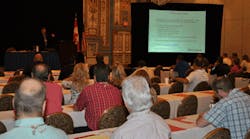Latest from Home
Work Truck Week 2025 Welcomes More Than 16,000
Sponsored
CONNECT 2010 gives contractors insight into business planning, social media
LAS VEGAS — This October, plumbing and HVAC contractors attended the first joint Quality Service Contractors and the Plumbing-Heating-Cooling Contractors — National Association conference, CONNECT 2010, here. The conference offered plumbing and HVACR contractors a variety of educational and networking opportunities, from QSC sessions regarding social media and how to prosper in difficult times to PHCC sessions on lean works in construction and lean applied in service.
In the session Branding and Lead Generation, Craig Chevrier, director of accounts and strategy, Vermont Design Works, a graphic design and website development services company, spoke to contractors about online marketing and social media.
In order to increase traffic, a company needs to have a blog that is updated weekly with specific content, and weekly Facebook and Twitter posts with special promotions for Facebook and Twitter followers only, Chevrier told session attendees. He also stressed to be sincere and not to sound like sales copy.
“Social marketing is also a great way to get mileage out of content,” said Chevrier. “Update social media accounts when you update your website and blog. The most important are Facebook, Twitter and LinkedIn.
“Remember you can generate leads from these sites and they are free,” added Chevrier. “You need to take your content and put it in all the different places where your customers are hanging out, like Facebook and Twitter.”
In the Social Media and Content Strategy session, contractors were once again told to avoid advertorial and repetitive copy, especially when posting a blog.
Nadia Romeo, president, iMarket Solutions, a website design, optimization and marketing solutions company, gave contractors tips for writing a successful blog, which includes updating blogs weekly, adding tags to each post, categorizing posts on popular key words and displaying blog comments and adding links.
“We are going to start making weekly contributions to our blog,” said Jessica Burden, sales manager at Milton Frank Plumbing Company, Spring, Texas. “We learned that our blog needs to be connected to our Website, so that Google recognizes that our Website has been updated.”
Regarding social media, Romeo told attendees to be patient.
“You must use a combination of multiple communication tools to be successful,” said Romeo. “Sometimes it takes a while to build Facebook fans. The more people you gain, the more people will join. Social media is to share information that is important to your audience. Treat them as a friend and respond to posts in a timely manner.”
Romeo also stressed that social media will help generate more website traffic, build brand awareness, manage the company brand and generate more leads and sales.
“Social media will be and is a critical factor in the success or failure of any business,” said Romeo. “Social media doesn’t cost you anything. It is a must to participate in social media for better control of the brand and what people are saying.”
Prospering in hard times
During the session The Top Nine Reasons Family Businesses Fail and the Secret to Prospering in Hard Times contractors listened attentively to Wayne Rivers, co-founder and president of The Family Business Institute Inc. and author of three books on family businesses.
According to Rivers when an entire organization depends on one person for all decisions, the entire organization is on one person’s shoulders.
“Instead you should want a business that runs really well if you show up or not,” Rivers told contractors.
Rivers also noted that poor leadership skills and development, no time for learning, and no system to hire the right people also contributes to family businesses failing.
“You need to trim headcount,” said Rivers. “The most capable people get the most responsibility and assignments, which renders them less capable over time.
“You also need criteria to measure employees,” added Rivers. “One superstar in the company isn’t sufficient enough. You need good employees.”
After discussing what can cripple family businesses, Rivers discussed the eight building blocks for creating a sustainable business. Clear and compelling common vision; self-management, time management, and leadership development; people management; marketing and sales management; operations management; administration management; family management; and strategic planning and weekly execution all play an integral role in sustaining a family business.
According to Rivers, a clear vision rallies people to a better future, is more emotional than rational, is the antidote to anxiety, increases workers’ engagement and simplifies a complex world into a single organizing idea.
“He caused our company to take a hard look at some issues and topics we have been avoiding dealing with for a long time now,” said Burden, regarding Rivers’ presentation. “Being a second generation family owned and operated company this session touched home with us in more ways than one. We have started several things from Wayne’s session such as the time management, common visions, sharing numbers, etc.”
“I especially enjoyed the family business session because I work in a family plumbing company,” said Ben Friedman of Atlas Plumbing Co., Dallas, Texas. “We plan to have more meetings surrounding the current status of the business as well as the future, both short and long term. With all the new technologies and ideas coming to us every day we need to reign in what’s most important to our success and choose the right strategies going forward.”
Lean construction works
During the conference, Dennis Sowards, president of Quality Support Services Inc. and CONTRACTOR columnist, spoke about lean construction works.
According to Sowards, lean thinking is a concept of quality improvement and a shift in management's focus to differentiate between value and waste in order to develop a better way to deliver the job. Lean focuses on maximizing the whole project by all individuals and functions cooperating and focusing on keeping the crews installing.
Sowards explained some of the basic lean tools and techniques, including the Muda Walk and Last Planner System to contractors.
“Muda” in Japanese means waste. A Muda Walk is done to figure out what gets in the way of value — to watch and see how the work process is done. It is watching to see where improvements can be made in a process.
“Do Muda Walks to look at how the work is done and remove the barriers that limit work flow,” Sowards told contractors.
He also touched on the Last Planner System (LPS), one tool of Lean Construction that is popular among contractors, in which a manager must ask how a crew will be more productive: doing work as planned or doing unplanned work.
The LPS, a registered trademark of the Lean Construction Institute, consists of developing and using several key plans with a weekly meeting and constraints measurement. At the end of each week, the last planner identifies the constraints that kept work from being done as planned. These constraints are analyzed in a weekly coordination meeting and action is taken to prevent future occurrences. Part of this weekly cycle is measuring the percent of work completed.
According to Sowards, research shows that on average crews are doing the work they planned to do for the week only 54% of the time.
Lead by example
CONNECT 2010 ended with an inspirational presentation by Keni Thomas, a member of the Army’s Ranger Task Force and country music singer, about his experience as an Army Ranger in the mission that resulted in “Blackhawk Down,” and the preparation, training and leadership that members of the Ranger Task Force go through, which can be applied to running a business.
“Leading by example is directly related to success,” Thomas told contractors. “You need to plan, train and lead, so when something difficult comes up you can execute what you do. You also need standard operating procedures — these are absolutely necessary.
“You don’t get to choose who you work with; you need to make sure you work to the highest standard,” he continued. “You are as strong as your weakest link. As good as you are, you can’t do everything. You need people around you to help out.
“If you plan well enough in advance and implement training, you can improve yourself at what you do.”
Related Articles:
PHCC’s Connect 2010 to give contractors tools to reenergize
Candace Roulo
Candace Roulo, senior editor of CONTRACTOR and graduate of Michigan State University’s College of Communication Arts & Sciences, has 15 years of industry experience in the media and construction industries. She covers a variety of mechanical contracting topics, from sustainable construction practices and policy issues affecting contractors to continuing education for industry professionals and the best business practices that contractors can implement to run successful businesses.


